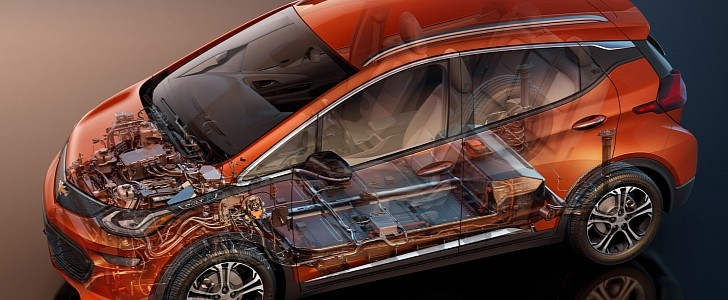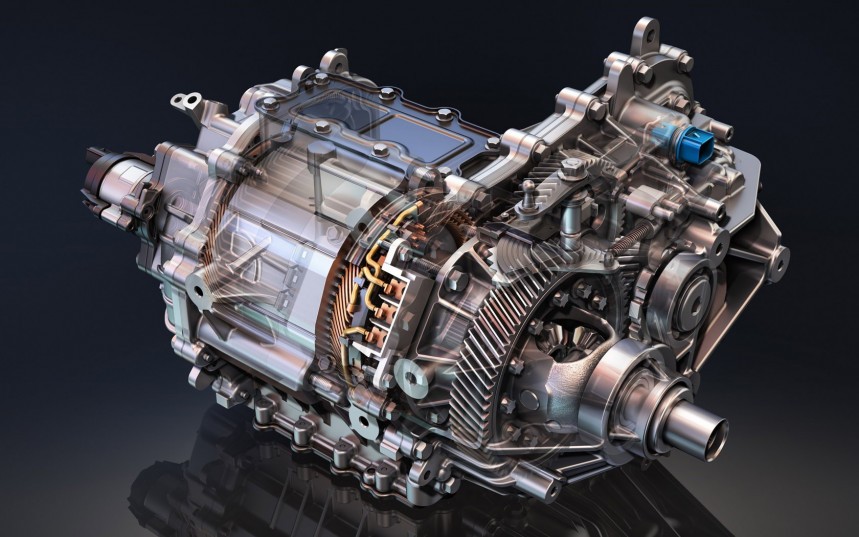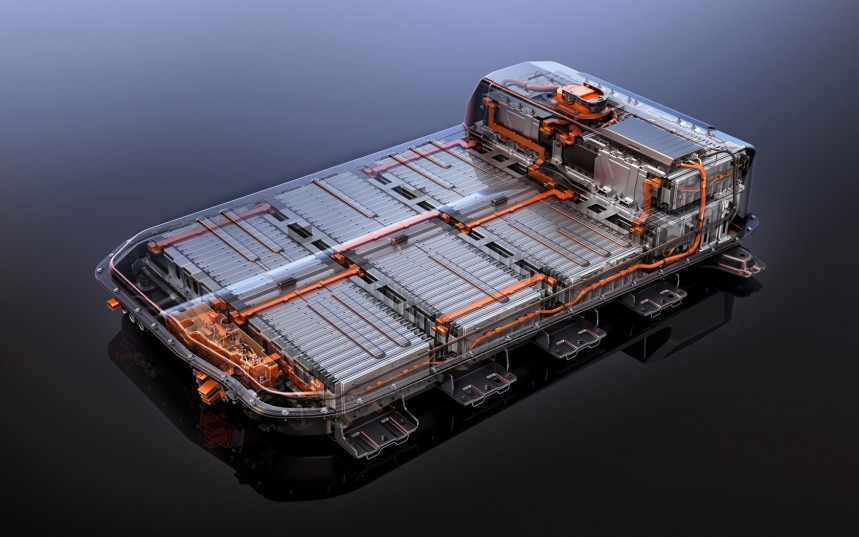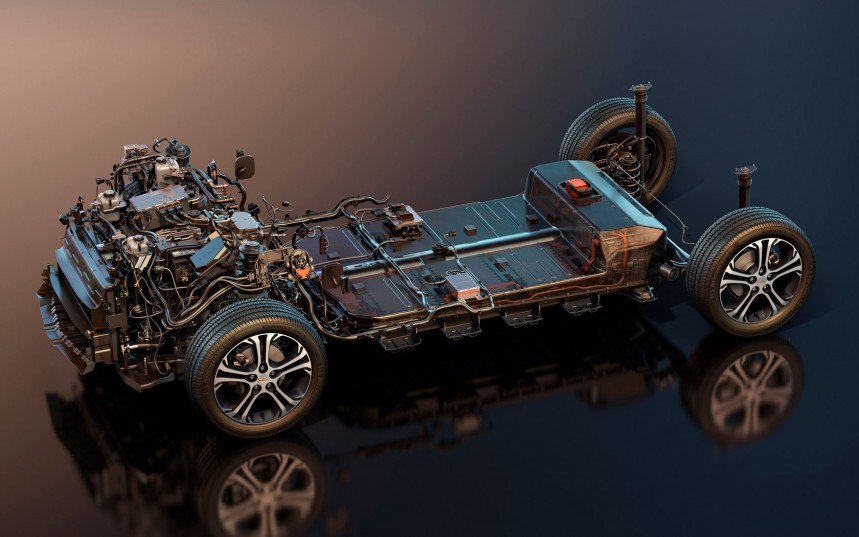Big things come in small packages is a saying that fits perfectly for the Bolt EV, an affordable little car powered by a simple yet powerful drivetrain that sets new standards for long-range electric vehicles.
The roots of the Bolt can be traced back to South Korea, where a team of 180 people from the local GM branch started developing the concept car in 2012.
It debuted in 2015 at the North American International Auto Show with the production beginning one year later, after General Motors had tested more than 50 Bolt hand-built prototypes.
The small hatchback’s drive system uses a single high capacity permanent magnet motor/generator that is designed with an offset gear and shaft configuration which improves efficiency and performance.
It can launch the Bolt from 0 to 60 mph (0 to 97 kph) in less than seven seconds thanks to the laudable power output of 200 hp (149 kW) and the 266 lb. ft (361 Nm) of torque.
Power delivery is aided by the Electronic Precision Shift system, which is the first of its kind in Chevrolet history. This shift and park-by-wire system sends electronic impulses to the drive unit that manages power and torque based on the selected driving mode.
The Bolt features a new regenerative braking system that can provide one pedal driving when operating the car in 'Low' mode, or by using the 'Regen on Demand' paddle placed on the back of the steering wheel.
The driver can bring the vehicle to a complete stop under most circumstances by simply lifting their foot off the accelerator.
The battery pack responsible for providing energy to the motor is made by LG Electronics and has been improved from 60 kWh to 66 kWh for the 2020 model year, making the Bolt capable of an EPA estimated range of 259 miles (417 km).
It is composed of 288 flat "landscape" cells bundled into groups of three connected in parallel and 96 groups connected in series, weighing a total of 960 lb. (440 kg). It is an active structural element of the chassis and accounts for 23% of the car's value.
The nickel-rich lithium-ion chemical makeup of the battery provides improved thermal operating performance, which is controlled by a simple 6.9-liter liquid cooling system.
The pack is connected to a standard 7.2 kW onboard charger that can be used for overnight charging from a 240-V wall box. A factory option that supports rapid DC charging is also available.
The chassis features an independent MacPherson strut-type front suspension with side load compensating and finely tuned springs. It is also equipped with a direct-acting solid stabilizer bar system and handling oriented LCA bushings.
On the rear, the torsion beam type suspension features a closed section V-shaped profile axle. Also, specifically tuned coil springs are aided by performance balanced shock absorbers.
Also, angled A-bushing work against an understeer tendency on cornering maneuvers and a kinematically optimized torsion beam provides a stable ride and agile handling.
The Bolt EV is a very fun car to drive considering its curb weight of 3,563 lbs. (1,616 kg) and the 62.8 in (1,595 mm) height of the car. Since the battery is placed underneath the floor, it lowers the center of gravity providing surprisingly good handling
It has a superior range compared to other far more expensive EVs and offers enough room for five people and a little bit of trunk space. However, it does not come with a ‘frunk’, the front compartment being occupied by the electric motor.
It debuted in 2015 at the North American International Auto Show with the production beginning one year later, after General Motors had tested more than 50 Bolt hand-built prototypes.
The small hatchback’s drive system uses a single high capacity permanent magnet motor/generator that is designed with an offset gear and shaft configuration which improves efficiency and performance.
Power delivery is aided by the Electronic Precision Shift system, which is the first of its kind in Chevrolet history. This shift and park-by-wire system sends electronic impulses to the drive unit that manages power and torque based on the selected driving mode.
The Bolt features a new regenerative braking system that can provide one pedal driving when operating the car in 'Low' mode, or by using the 'Regen on Demand' paddle placed on the back of the steering wheel.
The driver can bring the vehicle to a complete stop under most circumstances by simply lifting their foot off the accelerator.
The battery pack responsible for providing energy to the motor is made by LG Electronics and has been improved from 60 kWh to 66 kWh for the 2020 model year, making the Bolt capable of an EPA estimated range of 259 miles (417 km).
The nickel-rich lithium-ion chemical makeup of the battery provides improved thermal operating performance, which is controlled by a simple 6.9-liter liquid cooling system.
The pack is connected to a standard 7.2 kW onboard charger that can be used for overnight charging from a 240-V wall box. A factory option that supports rapid DC charging is also available.
The chassis features an independent MacPherson strut-type front suspension with side load compensating and finely tuned springs. It is also equipped with a direct-acting solid stabilizer bar system and handling oriented LCA bushings.
On the rear, the torsion beam type suspension features a closed section V-shaped profile axle. Also, specifically tuned coil springs are aided by performance balanced shock absorbers.
The Bolt EV is a very fun car to drive considering its curb weight of 3,563 lbs. (1,616 kg) and the 62.8 in (1,595 mm) height of the car. Since the battery is placed underneath the floor, it lowers the center of gravity providing surprisingly good handling
It has a superior range compared to other far more expensive EVs and offers enough room for five people and a little bit of trunk space. However, it does not come with a ‘frunk’, the front compartment being occupied by the electric motor.












